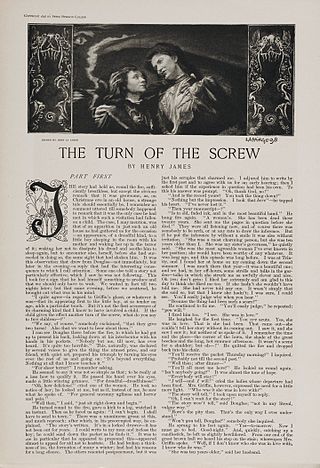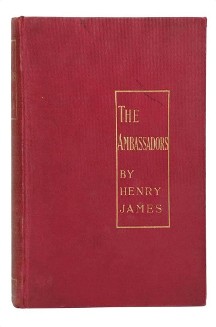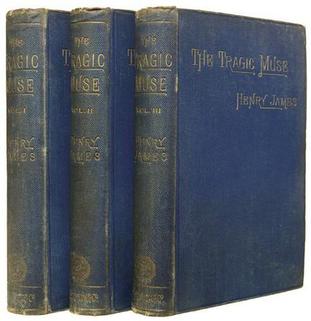
Henry James was an American-British author. He is regarded as a key transitional figure between literary realism and literary modernism, and is considered by many to be among the greatest novelists in the English language. He was the son of Henry James Sr. and the brother of philosopher and psychologist William James and diarist Alice James.

The Turn of the Screw is an 1898 horror novella by Henry James which first appeared in serial format in Collier's Weekly. In October 1898, it was collected in The Two Magics, published by Macmillan in New York City and Heinemann in London. The novella follows a governess who, caring for two children at a remote estate, becomes convinced that the grounds are haunted. The Turn of the Screw is considered a work of both Gothic and horror fiction.

The Portrait of a Lady is a novel by Henry James, first published as a serial in The Atlantic Monthly and Macmillan's Magazine in 1880–81 and then as a book in 1881. It is one of James's most popular novels and is regarded by critics as one of his finest.

The Ambassadors is a 1903 novel by Henry James, originally published as a serial in the North American Review (NAR). The novel is a dark comedy which follows the trip of protagonist Lewis Lambert Strether to Europe to bring the son of his widowed fiancée back to the family business. The novel is written in the third-person narrative from Strether's point of view.

Francis Otto Matthiessen was an educator, scholar and literary critic influential in the fields of American literature and American studies. His best known work, American Renaissance: Art and Expression in the Age of Emerson and Whitman, celebrated the achievements of several 19th-century American authors and had a profound impact on a generation of scholars. It also established American Renaissance as the common term to refer to American literature of the mid-nineteenth century. Matthiessen was known for his support of liberal causes and progressive politics. His contributions to the Harvard University community have been memorialized in several ways, including an endowed visiting professorship.
Joseph Leon Edel was an American/Canadian literary critic and biographer. He was the elder brother of North American philosopher Abraham Edel.

Guy Domville is a play by Henry James first staged in London in 1895. The première performance ended with the author being jeered by a section of the audience as he bowed onstage at the end of the play. This failure largely marked the end of James's attempt to conquer the theatre. He returned to his narrative fiction and recorded this memorable pledge in his Notebooks on 23 January 1895: "I take up my own old pen again – the pen of all my old unforgettable efforts and sacred struggles. To myself – today – I need say no more. Large and full and high the future still opens. It is now indeed that I may do the work of my life. And I will."

The Bostonians is a novel by Henry James, first published as a serial in The Century Magazine in 1885–1886 and then as a book in 1886. This bittersweet tragicomedy centres on an odd triangle of characters: Basil Ransom, a political conservative from Mississippi; Olive Chancellor, Ransom's cousin and a Boston feminist; and Verena Tarrant, a pretty, young protégée of Olive's in the feminist movement. The storyline concerns the struggle between Ransom and Olive for Verena's allegiance and affection, though the novel also includes a wide panorama of political activists, newspaper people, and quirky eccentrics.

The Tragic Muse is a novel by Henry James, first published as a serial in The Atlantic Monthly in 1889-1890 and then as a book in 1890. This wide, cheerful panorama of English life follows the fortunes of two would-be artists: Nick Dormer, who throws over a political career in his efforts to become a painter, and Miriam Rooth, an actress striving for artistic and commercial success. A cast of supporting characters help and hinder their pursuits.

The Other House is a novel by Henry James, first published as a serial in the Illustrated London News in 1896 and then as a book later the same year. Set in England, this book is something of an oddity in the James canon for its plot revolving around a murder. The novel was originally planned as a play called The Promise. James sketched a scenario for the play in 1893, but it didn't interest theater managers. In 1896 James converted the scenario into The Other House for publication in a popular weekly magazine. He converted the novel back into a play in 1909, but it again failed to be produced.

Hawthorne is a book of literary criticism by Henry James published in 1879. The book was a study of James' great predecessor Nathaniel Hawthorne. James gave extended consideration to each of Hawthorne's novels and a selection of his short stories. He also reviewed Hawthorne's life and some of his nonfiction. The book became somewhat controversial for a famous section in which James enumerated the items of novelistic interest he thought were absent from American life.
Partial Portraits is a book of literary criticism by Henry James published in 1888. The book collected essays that James had written over the preceding decade, mostly on English and American writers. But the book also offered treatments of Alphonse Daudet, Guy de Maupassant and Ivan Turgenev. Perhaps the most important essay was The Art of Fiction, James' plea for the widest possible freedom in content and technique in narrative fiction.

Notes on Novelists is a book of literary criticism by Henry James published in 1914. The book collected essays that James had written over the preceding two decades on French, Italian, English and American writers. The book also contained a controversial essay, The New Novel, 1914, which passed judgment on various contemporary writers and occasioned much disagreement.
Lyall H. Powers was a professor of English at the University of Michigan, where he taught since 1958. He was granted emeritus status by the University's Regents during their October 1992 meeting.
A Passionate Pilgrim is a novella by Henry James, first published in The Atlantic Monthly in 1871. The story was the earliest fiction that James included in the New York Edition (1907–09) of his works. Set in England, the tale shows James' strong interest in the contrast between the Old World and the New. In fact, the difference between America and Europe erupts into open conflict in the story, which leads to an ironic ending.
The Author of Beltraffio is a short story by Henry James, first published in the English Illustrated Magazine in 1884. This macabre account of desperate family infighting eventually leads to a tragic conclusion. Although the father in the story is a novelist, the tale concentrates far more on his family relationships than on his special concerns as a writer, though some of those concerns affect the outcome.

"The Altar of the Dead" is a short story by Henry James, first published in his collection Terminations in 1895. A fable of literally life and death significance, the story explores how the protagonist tries to keep the remembrance of his dead friends, to save them from being forgotten entirely in the rush of everyday events. He meets a woman who shares his ideals, only to find that the past places what seems to be an impassable barrier between them. Although James was not religious in any conventional sense, the story shows a deep spirituality in its treatment of mortality and the transcendent power of unselfish love.

The New York Edition of Henry James' fiction was a 24-volume collection of the Anglo-American writer's novels, novellas and short stories, originally published in the U.S. and the UK between 1907 and 1909, with a photogravure frontispiece for each volume by Alvin Langdon Coburn. Two more volumes containing James' unfinished novels, The Ivory Tower and The Sense of the Past, were issued in 1917 in a format consistent with the original set. The entire collection was republished during the 1960s by Charles Scribner's Sons. The official title of the set was The Novels and Tales of Henry James, though the more informal title was suggested by James himself and appears as a subtitle on the series title page in each volume. It has been used almost exclusively by subsequent commentators.

The Death of the Lion is an 1894 short story by Henry James.

Theodora Bosanquet MBE was a writer, reviewer, editor, secretary, and amanuensis to Henry James. She worked as Executive Secretary of the International Federation of University Women, as well as being a contributor to, and subsequently director and literary editor of, the political and literary magazine Time and Tide. Her memoir, Henry James at Work (1924) is viewed today as 'a pioneer work of critical biography'.










